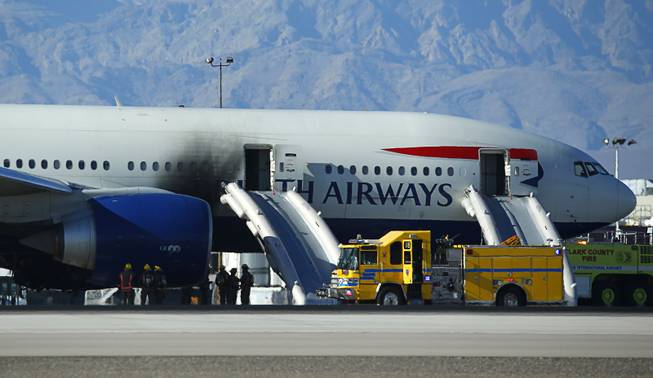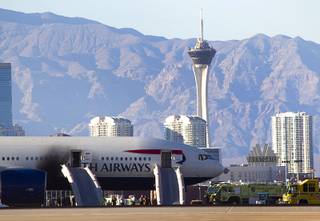
John Locher / AP
Firefighters stand by a British Airways plane that caught fire Tuesday, Sept. 8, 2015, at McCarran International Airport. An engine on the plane caught fire before takeoff, forcing passengers to escape on emergency slides.
Published Friday, Feb. 26, 2016 | 10:15 a.m.
Updated Friday, Feb. 26, 2016 | 4:11 p.m.
A British Airways jet that was damaged by fire during an aborted takeoff in September flew from Las Vegas to a California airport on Friday after six months of repairs including an engine replacement and fuselage patch.
The Boeing 777 took a circuitous route over the Mojave Desert to Victorville, where it will be repainted before being flown back to the United Kingdom, airline spokeswoman Michele Kropf said.
Flight records showed the big twin-engine aircraft departed McCarran International Airport about 1:30 p.m. and arrived 90 minutes later at Southern California Logistics Airport.
The flight test followed engine testing late Thursday on an inactive runway at McCarran.
A National Transportation Safety Board investigation of the Sept. 8 fire is continuing.
British Airways Flight 2276 was barreling down a runway for takeoff and what would have been a 10-hour flight to London with 157 passengers and 13 crew members aboard when its left engine burst into flames.
The plane screeched to a halt with fire and smoke billowing beneath the wing while all 170 people escaped down evacuation slides. No one was seriously hurt.
Since then, the aircraft has remained in a corner of the McCarran property while the fire-damaged General Electric engine was removed and replaced by the manufacturer.
Airport spokeswoman Christine Crews said Friday it racked up $65,000 in parking fees, and other costs once repairs began.
Victoria Madden, a British Airways spokeswoman in New York, said in a statement that Boeing technicians worked to repair the aircraft "to the same high standards as if the aircraft was brand new."
A Boeing spokesman referred questions to British Airways.
The aircraft was built in 1998, outfitted with GE90 engines of the type used in most Boeing 777s. It was registered to British Airways a year later. In its 14 years of service, it flew nearly 77,000 hours, according to the British Civil Aviation Authority.
Early NTSB findings were that a catastrophic failure occurred at a crucial compression point when the engine was under the highest pressure, although investigators said they weren't immediately sure what caused it.
On the tarmac, investigators recovered several 7- to 8-inch fragments from the spool assembly of the high-pressure engine compressor. They noted some shards apparently sliced through the armored shell around the engine.
GE Aviation spokesman Rick Kennedy said Friday the company examined more than 50 model GE90 engines of similar configuration and age, and found no anomalies and no clues about what might have caused the fire.
"Those engines were without issue," Kennedy said. "We're looking at other early-model GE90s to see if there's a pattern. So far, they haven't found anything."
GE Aviation has said the spool, which holds the blades in the GE90-85B engine, was among the first made for that model in 1995.
About 400 base GE90 engines are being used to power 167 aircraft worldwide, according to the company.
Kennedy said the spool and blades of all GE90 engines built before 2001 are being inspected during scheduled overhaul and maintenance.


Join the Discussion:
Check this out for a full explanation of our conversion to the LiveFyre commenting system and instructions on how to sign up for an account.
Full comments policy